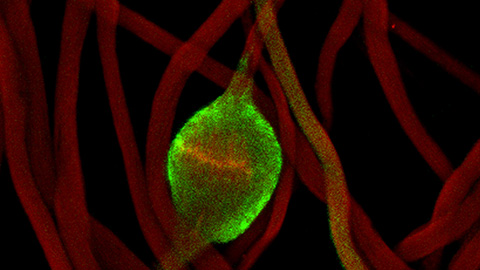Huntingtin through a multiomic lens
Tracing the effects of a single gene’s mutation can be hard. Huntington’s disease, for example, is caused by just one mutation — but that change reverberates throughout the brain. Research published in the journal Molecular & Cellular Proteomics shows that the mutant protein that causes Huntington’s can alter the binding properties of another protein, perhaps accounting for some of the mutation’s far-flung cellular effects.

Huntington’s disease, an as-yet-untreatable neurodegenerative disorder, is caused by a mutation that affects the protein huntingtin. Huntingtin is large to begin with; in patients, a repeat region in the gene adds an expanding tract of glutamine residues to the protein, making it sticky and prone to aggregate. But how the protein change leads to profound problems in neurons is up for debate.
“Very few proteins act as a monolithic structure,” said Joel Federspiel, a postdoctoral fellow in Ileana Cristea’s lab at Princeton University. Instead, most act in coordination with other proteins. The same is probably true for huntingtin — but previous interactomics studies turned up thousands of binding partners. Which ones are important for the way the disease develops?
Recent research had shown that reducing neuronal levels of the protein HDAC4, which binds to mutated huntingtin, may reduce Huntington’s symptoms, at least in mice. Oddly, however, blocking the enzymatic activity of HDAC4, which belongs to a class of enzymes that alter histone proteins that organize DNA, did not have the same effect.
To Federspiel and Cristea, the data suggested that HDAC4 was contributing to the onset of disease through a binding interaction either with huntingtin or with other proteins. So they hopped one ripple ring away from huntingtin protein itself to study how HDAC4 changes in a brain affected by the disease.
The researchers used immunoaffinity purification followed by mass spectrometry to catalogue all of the proteins that interact with HDAC4 in the mouse brain. In a mouse model of Huntington’s, they found major changes to the HDAC4 interactome around the age at which symptoms start to appear.
“You can, in a case like this, have hundreds to thousands of proteins or transcripts that are differentially regulated,” Federspiel said. “Trying to home in on just a few of those to focus on can be challenging. However, if you have more lines of evidence, then you start to see what things are common.”
To find the significant proteins, they layered in additional data from earlier transcriptome and proteome studies. After they applied what they called a lens of multiomics, a few insights came into focus.
In the mice with huntingtin mutations that were old enough to exhibit symptoms, HDAC4 associated with many huntingtin-binding proteins — more so than in the brains of healthy mice or younger mutants.
Many of the interacting proteins were involved in the organization of synapses and vesicle transport. In the mutant mice, those proteins interact with HDAC4 much more strongly. The effect was most noticeable in cells in the striatum, a brain region that controls movement and is affected greatly in Huntington’s disease.
That’s good circumstantial evidence that, in Huntington’s-affected brains, a changing HDAC4 interactome may contribute to symptoms. Exactly how, the researchers say, remains to be determined.
Enjoy reading ASBMB Today?
Become a member to receive the print edition four times a year and the digital edition monthly.
Learn moreGet the latest from ASBMB Today
Enter your email address, and we’ll send you a weekly email with recent articles, interviews and more.
Latest in Science
Science highlights or most popular articles

Cholesterol as a novel biomarker for Fragile X syndrome
Researchers in Quebec identified lower levels of a brain cholesterol metabolite, 24-hydroxycholesterol, in patients with fragile X syndrome, a finding that could provide a simple blood-based biomarker for understanding and managing the condition.

How lipid metabolism shapes sperm development
Researchers at Hokkaido University identify the enzyme behind a key lipid in sperm development. The findings reveal how seminolipids shape sperm formation and may inform future diagnostics and treatments for male infertility.

Mass spec method captures proteins in native membranes
Yale scientists developed a mass spec protocol that keeps proteins in their native environment, detects intact protein complexes and tracks drug binding, offering a clearer view of membrane biology.

Laser-assisted cryoEM method preserves protein structure
University of Wisconsin–Madison researchers devised a method that prevents protein compaction during cryoEM prep, restoring natural structure for mass spec studies. The approach could expand high-resolution imaging to more complex protein systems.

Method sharpens proteome-wide view of structural changes
Researchers developed a method that improves limited proteolysis coupled with mass spectrometry, separating true changes from abundance or splicing effects.

Discoveries made possible by DNA
The discovery of DNA’s double helix revealed how genetic information is stored, copied and expressed. Revisit that breakthrough and traces how it laid the foundation for modern molecular biology, genomics and biotechnology.

